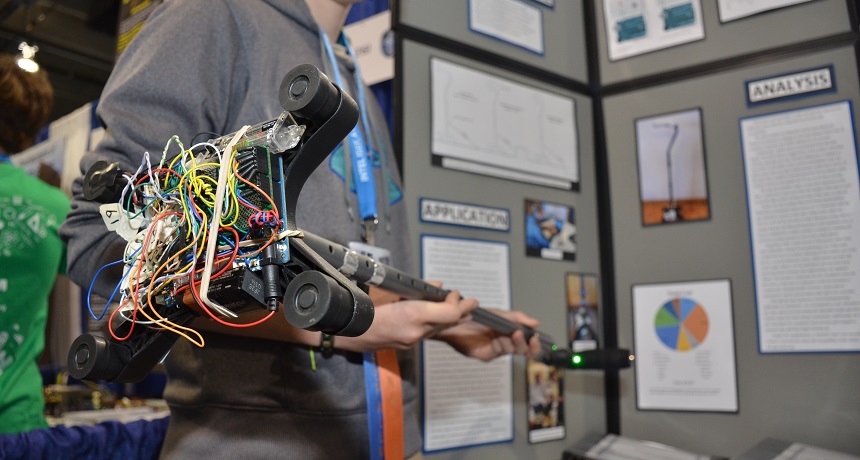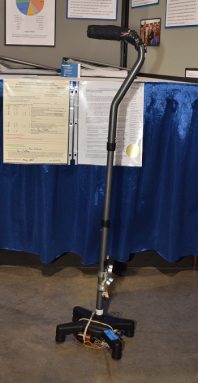Stepping out with a smarter cane
A teen develops a better cane to help the elderly

Mary Hood shows off her smart cane. The nest of wires underneath helps power the sensors that help the cane sense obstacles.
L. Buitrago/SSP
Share this:
- Share via email (Opens in new window) Email
- Click to share on Facebook (Opens in new window) Facebook
- Click to share on X (Opens in new window) X
- Click to share on Pinterest (Opens in new window) Pinterest
- Click to share on Reddit (Opens in new window) Reddit
- Share to Google Classroom (Opens in new window) Google Classroom
- Click to print (Opens in new window) Print
PITTSBURGH, Pa. — As people get older, they can have a tough time getting around. The elderly sometimes develop vision problems. They can also begin to lose their sense of balance. This explains why older people at are high risk of tripping and falling. And that can lead to broken bones and worse. But one teen showed that sometimes technology can keep seniors up and moving — including her own grandmother.
Mary Hood, 17, has developed a cane that’s more than a walking stick. It senses stairs, curbs and other potential hazards. It also tracks its users’ heart rates, reminds them to take their medication and even lights the path ahead. A junior at Sargent High School in Monte Vista, Colo., Mary brought her invention here, to the International Science and Engineering Fair. Sponsored by Intel and run by Society for Science & the Public, this competition brings together students from all over the world to show off their scientific research and inventions. (SSP also published Science News for Students and this blog.)

Her new “smart” cane is full of sensors. Some measure elevation by sending out tiny pulses of very high-pitched sound — a frequency that humans cannot hear. That sound bounces off of objects ahead, such as a coffee table, and then returns to the sensor. By measuring the time it takes for the sound to return, the cane can calculate how far away the coffee table is. If the cane gets too close, its sensors make the cane handle vibrate, warning the walker to watch out.
Gripping the cane’s handle can collect data on how fast a user’s heart is beating. If it’s too high or too low, the user may be at risk of fainting. So the cane will vibrate and let its user know that it’s time to find a seat and rest. The cane also comes equipped with lights and a computer. That computer can be programmed to notify users when it’s time to take any medication.
But Mary felt the most important thing was to make her high-tech cane appeal to the older people who might need it. “That’s why the alert method is through vibration,” Mary explains. “I chose that because it’s tactile. So if you can’t hear a buzzer or see a light you can feel the vibration.” Those vibrations are also subtle. They don’t attract much notice. That means “you can use it in church or in the movies and it’s not bothering people,” the teen notes.
Although Mary had her grandmother in mind when she worked on the cane, she hopes it ultimately will benefit many others. “Engineering is the way for me to build something that makes a difference in people’s lives,” she says.
The teen has applied to patent the cane as she continues to improve its design. “The elderly population is very underserved when it comes to technology,” Mary says. And with the share of senior citizens continuing to grow, she argues, “We’re going to have to look to technology for solutions.”
Follow Eureka! Lab on Twitter
Power Words
(for more about Power Words, click here)
blood pressure The force exerted against vessel walls by blood moving through the body. Usually this pressure refers to blood moving specifically through the body’s arteries. That pressure allows blood to circulate to our heads and keeps the fluid moving so that it can deliver oxygen to all tissues. Blood pressure can vary based on physical activity and the body’s position. High blood pressure can put someone at risk for heart attacks or stroke. Low blood pressure may leave people dizzy, or faint, as the pressure becomes too low to supply enough blood to the brain.
engineer A person who uses science to solve problems. As a verb, to engineer means to design a device, material or process that will solve some problem or unmet need.
frequency The number of times a specified periodic phenomenon occurs within a specified time interval. (In physics) The number of wavelengths that occurs over a particular interval of time.
patent A legal document that gives inventors control over how their inventions — including devices, machines, materials, processes and substances — are made, used and sold for a set period of time. Currently, this is 20 years from the date you first file for the patent. The U.S. government only grants patents to inventions shown to be unique.
sensor A device that picks up information on physical or chemical conditions — such as temperature, barometric pressure, salinity, humidity, pH, light intensity or radiation — and stores or broadcasts that information. Scientists and engineers often rely on sensors to inform them of conditions that may change over time or that exist far from where a researcher can measure them directly.
Society for Science and the Public (or SSP) A nonprofit organization created in 1921 and based in Washington, D.C. Since its founding, SSP has been not only promoting public engagement in scientific research but also the public understanding of science. It created and continues to run the Intel International Science and Engineering Fair (initially launched in 1950). SSP also publishes award-winning journalism in Science News (launched in 1922) and Science News for Students (created in 2003). Those magazines also host a series of blogs (including Eureka! Lab).
tactile An adjective that describes something that is or can be sensed by touching.







